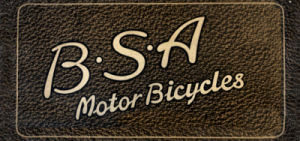

A report on the Motor Cycle Show of November 1924 reads, in part:
"The range of B.S.A. motor cycles for 1925 is substantially the same as that which has been in existence throughout the past year. Two new models, it is true, have appeared in the interim, but these have been specially developed for overseas work.
The 3.49 overhead valve and side-valve models have been strengthened in the frame so as to allow for the fitting of a light sidecar. As to the rest of the range, which covers machines from 2.49 h.p. to 9.86 h.p., detailed alterations include the fitting of grease gun lubricators to cycle bearings in all except the smallest models, and the total enclosure of the front brakes to prevent the risk of dirt and grit getting to the fulcrum and springs. On all models the cush drive is now automatically lubricated by oil mist carried from the crank case through holes in the engine main shaft. A new type of clutch lever giving a straight pull, is now used in conjunction with a large diameter cable.
Some interesting looking semi-sports sidecars are shown on the stand and the sports skiff when fitted to the 3.49 O.H.V. forms a really sporting outfit.
The two special overseas models to which we have already referred, are designed to give increased ground clearance and improved weather protection.
It is impossible in the space at our command to enumerate all the B.S.A. models and prices. The smallest model of 2.49 h.p. sells at ..., and the 9.86 h.p. De Luxe at £80. Sidecar prices range from £15 to £28."
B.S.A. Cycles, Ltd., Small Heath, Birmingham.
Information courtesy Motor Sport Magazine
Reports on sports machines of 1926 (penned in 1949)
"A rider unaccustomed to acting as a motor-cycle critic dealt with the next machine, the No. 1 3.49-h.p. o.h.v. "Super Sports" B.S.A. The photographs show a machine looking anything but sporting. The B.S.A. was used for hectic dispatch-riding duties during the General Strike, and first impressions were of a stable, well-mudguarded job with good sprung-forks and Terry saddle - although the h.t. lead did short against the rider's wet coat.
An h.c. piston and strong valve springs did not preclude crawling in top gear, although the more normal tune would have been happier in towns. However, the reward for a little non-docility was grand acceleration and speeds of 35 to 37 m.p.h. in bottom gear, 60 m.p.h. in second, in spite of a touring engine sprocket, and 75 m.p.h. in top with more to come. It was thought that with the magdyno replaced by a magneto, 80 m.p.h. would have been possible - from a touring looking "350"! And, even under National Emergency traffic conditions in London, the T.T. Amac carburetter gave a good tick-over and there was no sign of overheating. The "Super Sports" B.S.A. made a very marked impression and short comings were confined to a carburetter fire when the magneto timing slipped, one side of the Lucas accumulator blowing out with a loud bang one dark night; a stiff clutch action; a tendency for the oiling system to gum-up the clutch, and a tendency for oil to leak from the engine chain cases on to the vicar's drive. But in impromptu dusts-up with Panthers, Squirrels and the like, along the Strand and similar thoroughfares during the strike, the B.S.A. was absolutely in its element."
Extract from a report on the 1926 Olympia Show:
"Another firm which, except for one ill-fated splash in 1921, has only just begun to nibble at the idea of something really fast, is our old friend the B.S.A. On Stand 20 we find the popular 350 c.c. o.h.v. B.S.A., which we reviewed last month, and which has proved very popular for fast touring and trials work to say nothing of motorcycle football ! The new 493 c.c. o.h.v. machine, however, should really attract the Brooklands, T.T. and Southport fiend, as its design incorporates so many features desired by this fraternity."
To begin with, it has a lubrication system, as opposed to " a pump or other suitable device" for inserting oil into the crankcase. Oil is pumped from the sump under pressure to main and big end bearings and timing gear. Lubrication is also provided for the o.h.v. gear and the primary chain."
As regards the machine itself, this has an inclined engine in a duplex cradle frame, with a saddle height of only 25 inches. Apart from these features, everything else conforms to modern racing practice, and the price is 05, which is in keeping with the reasonable prices charged for all B.S.A. models. In pre-war days the Triumph company used to be most successful in speed events with their standard sports models, and on the introduction of the four-valve machine there were many who hoped for a revival of this policy. However, the model R did not seem quite right for ultra racing speeds, so that it is now considered as a reliable fast touring machine, while for 1927 the new Horsman type two-valve machine is produced to cater for the speed-man. From observation it is clear that Horsman's own machine without steering damper is easily one of the steadiest on the track, and compared with most machines extraordinarily reliable. If the production machine embodies these traits it should seriously threaten some of the old established leaders in the 500 c.c. sports class. The price of £66, too, is distinctly competitive."